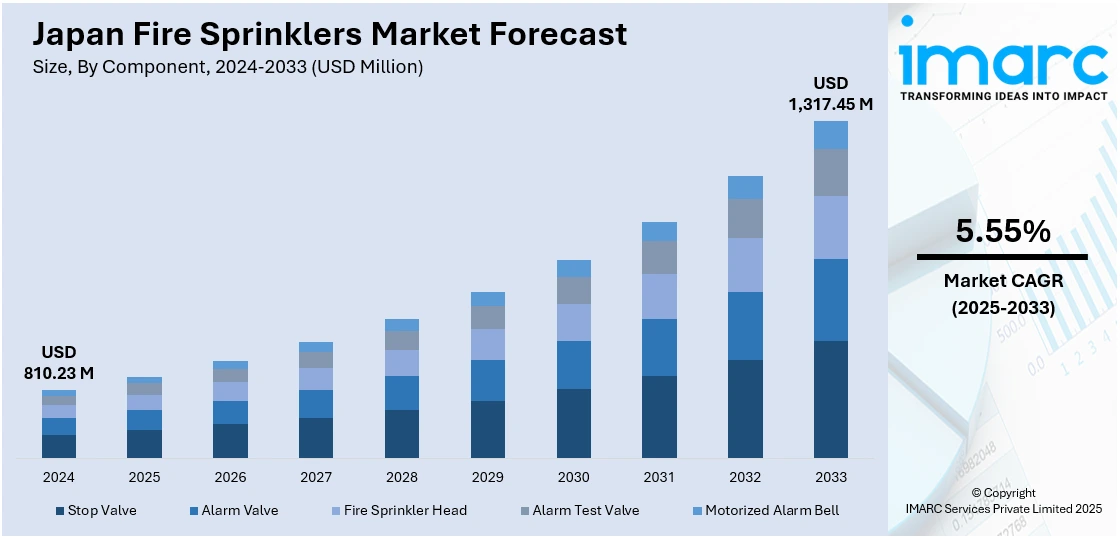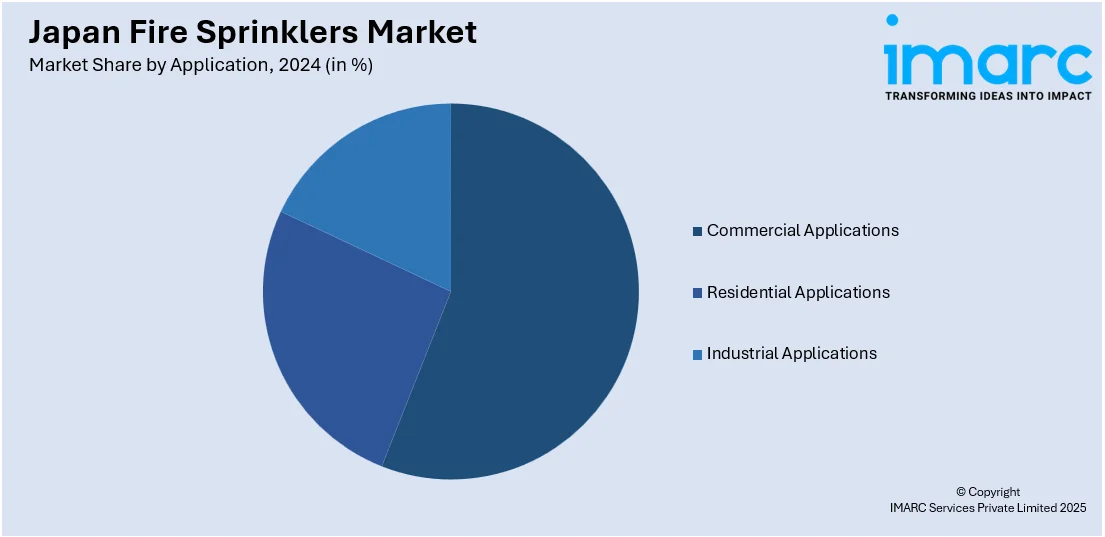
Japan Fire Sprinklers Market Size, Share, Trends and Forecast by Component, Product Type, Service, Technology, Application, and Region, 2025-2033
Japan Fire Sprinklers Market Overview:
The Japan fire sprinklers market size reached USD 810.23 Million in 2024. Looking forward, IMARC Group expects the market to reach USD 1,317.45 Million by 2033, exhibiting a growth rate (CAGR) of 5.55% during 2025-2033. The market is driven by stringent government regulations, recurrent seismic activity that necessitates higher safety levels, and increasing urban infrastructure development. Rising awareness regarding fire risk mitigation and smart sprinkler technologies also fuel higher adoption rates of sprinklers in residential, commercial, and high-risk industrial properties throughout the country.
|
Report Attribute
|
Key Statistics
|
|---|---|
|
Base Year
|
2024
|
|
Forecast Years
|
2025-2033
|
|
Historical Years
|
2019-2024
|
| Market Size in 2024 | USD 810.23 Million |
| Market Forecast in 2033 | USD 1,317.45 Million |
| Market Growth Rate 2025-2033 | 5.55% |
Japan Fire Sprinklers Market Trends:
Stringent Fire Safety Regulations
The Japan fire sprinklers market growth is largely influenced by the strict fire safety laws in the country. The government has strategically employed extensive building codes that require fire suppression systems, such as sprinklers, to be installed in different buildings. For example, Kayabuki no Sato, a historically significant village located in the Kyoto Prefecture of Japan, has a system of 62 automatic water hoses, installed to mitigate fire hazards. Fifty of its houses were constructed during the Edo period while some others were constructed 150 years ago in the Meiji period, out of which 39 houses have thatched roofs. The giant sprinkler system was set up after the village was designated as an Important Preservation District in the year 1993, with every nozzle concealed within small huts that match the overall aesthetic. Testing held twice a year in May and December has turned into a draw for tourists, with crowds gathering to witness the event, including the rainbows that occasionally appear above the thatched roofs. The government of Japan, hence, seeks to increase public safety and reduce the likelihood of fire outbreaks. Consequently, property developers, building owners, and facility managers are now investing more in fire sprinkler systems to achieve compliance and safeguard occupants. Compliance with these regulations has created a consistent demand for fire sprinkler installations in residential, commercial, and industrial buildings. Additionally, regular revisions to fire safety codes continue to promote the use of advanced fire protection technologies, making sure that systems continue to be effective in reducing fire risks. This regulatory environment is instrumental in determining the direction of the Japan fire sprinklers market outlook.

Technological Innovation in Fire Sprinkler Systems
The integration of advanced technologies is one of the major factors fueling the expansion of Japan's fire sprinkler industry. Companies are designing new sprinkler systems with intelligent sensors, IoT integration, and automatic controls. These technologies facilitate real-time monitoring, timely detection of fire risks, and instant sprinkler activation, thus improving the effectiveness and efficiency of fire suppression operations. Moreover, the use of corrosion-resistant materials and energy-efficient components helps ensure the durability and sustainability of fire sprinkler systems. The use of such sophisticated systems is especially common in high-risk settings, including data centers, hospitals, and factories, where quick response to fire outbreaks is essential. With the ongoing development of new technologies, the need for advanced fire sprinkler solutions will continue to increase, further fueling the Japan fire sprinklers market share.
Growth Across Different Industries
Japan's fire sprinkler industry is witnessing growth across various industries due to enhanced sensitivity to fire protection and the need to adhere to building regulations. Although commercial and industrial spaces have historically been the first adopters of fire sprinkler systems, their use in residential high-rise buildings, schools, and hospitals is also increasing. This widening application is credited to the awareness about fire hazards in multiple environments and the need to protect lives and property. Further, the increase in construction work and urban development projects has also spurred increased demand for fire sprinkler installations. Governmental incentives and subsidies for fire protection measures also help spread sprinkler systems to multiple industries. With market diversification, companies are customizing their products according to the individual requirements and regulations of each sector to provide the best possible fire protection solutions.
Japan Fire Sprinklers Market Segmentation:
IMARC Group provides an analysis of the key trends in each segment of the market, along with forecasts at the country and regional levels for 2025-2033. Our report has categorized the market based on component, product type, service, technology, and application.
Component Insights:
- Stop Valve
- Alarm Valve
- Fire Sprinkler Head
- Alarm Test Valve
- Motorized Alarm Bell
The report has provided a detailed breakup and analysis of the market based on the component. This includes stop valve, alarm valve, fire sprinkler head, alarm test valve, and motorized alarm bell.
Product Type Insights:
- Wet Pipe Fire Sprinklers
- Dry Pipe Fire Sprinklers
- Deluge Systems
- Pre-Action Systems
- Others
The report has provided a detailed breakup and analysis of the market based on the product type. This includes wet pipe fire sprinklers, dry pipe fire sprinklers, deluge systems, pre-action systems, and others.
Service Insights:
- Engineering Services
- Installation
- Design Maintenance
- Inspection
- Managed Services
- Others
A detailed breakup and analysis of the market based on the service has also been provided in the report. This includes engineering services, installation, design maintenance, inspection, managed services, and others.
Technology Insights:
- Active Fire Protection
- Passive Fire Protection
The report has provided a detailed breakup and analysis of the market based on the technology. This includes active fire protection and passive fire protection.
Application Insights:

- Commercial Applications
- Residential Applications
- Industrial Applications
A detailed breakup and analysis of the market based on the application has also been provided in the report. This includes commercial applications, residential applications, and industrial applications.
Regional Insights:
- Kanto Region
- Kansai/Kinki Region
- Central /Chubu Region
- Kyushu-Okinawa Region
- Tohoku Region
- Chugoku Region
- Hokkaido Region
- Shikoku Region
The report has also provided a comprehensive analysis of all the major regional markets, which include Kanto Region, Kansai/Kinki Region, Central /Chubu Region, Kyushu-Okinawa Region, Tohoku Region, Chugoku Region, Hokkaido Region, and Shikoku Region.
Competitive Landscape:
The market research report has also provided a comprehensive analysis of the competitive landscape. Competitive analysis such as market structure, key player positioning, top winning strategies, competitive dashboard, and company evaluation quadrant has been covered in the report. Also, detailed profiles of all major companies have been provided.
Japan Fire Sprinklers Market News:
- In March 2025, Shirakawa-go, a quaint village in Japan known for its ancient thatched-roof homes, has created an impressive strategy to safeguard its invaluable cultural heritage against the ongoing risk of fires. Located in the center of Gifu Prefecture in Japan, this UNESCO World Heritage site has effortlessly combined historic architecture with contemporary fire-safety innovations. Sixty strategically positioned sprinklers are prepared for immediate activation, forming a defensive barrier of high-pressure water around the village's valuable buildings. These concealed protectors, activated by heat and smoke detectors, can respond within moments of sensing peril, illustrating how contemporary technology can effortlessly merge with traditional environments.
Japan Fire Sprinklers Market Report Coverage:
| Report Features | Details |
|---|---|
| Base Year of the Analysis | 2024 |
| Historical Period | 2019-2024 |
| Forecast Period | 2025-2033 |
| Units | Million USD |
| Scope of the Report |
Exploration of Historical Trends and Market Outlook, Industry Catalysts and Challenges, Segment-Wise Historical and Future Market Assessment:
|
| Components Covered | Stop Valve, Alarm Valve, Fire Sprinkler Head, Alarm Test Valve, Motorized Alarm Bell |
| Product Types Covered | Wet Pipe Fire Sprinklers, Dry Pipe Fire Sprinklers, Deluge Systems, Pre-Action Systems, Others |
| Services Covered | Engineering Services, Installation, Design Maintenance, Inspection, Managed Services, Others |
| Technologies Covered | Active Fire Protection, Passive Fire Protection |
| Applications Covered | Commercial Applications, Residential Applications, Industrial Applications |
| Regions Covered | Kanto Region, Kansai/Kinki Region, Central /Chubu Region, Kyushu-Okinawa Region, Tohoku Region, Chugoku Region, Hokkaido Region, Shikoku Region |
| Customization Scope | 10% Free Customization |
| Post-Sale Analyst Support | 10-12 Weeks |
| Delivery Format | PDF and Excel through Email (We can also provide the editable version of the report in PPT/Word format on special request) |
Key Questions Answered in This Report:
- How has the Japan fire sprinklers market performed so far and how will it perform in the coming years?
- What is the breakup of the Japan fire sprinklers market on the basis of component?
- What is the breakup of the Japan fire sprinklers market on the basis of product type?
- What is the breakup of the Japan fire sprinklers market on the basis of service?
- What is the breakup of the Japan fire sprinklers market on the basis of technology?
- What is the breakup of the Japan fire sprinklers market on the basis of application?
- What is the breakup of the Japan fire sprinklers market on the basis of region?
- What are the various stages in the value chain of the Japan fire sprinklers market?
- What are the key driving factors and challenges in the Japan fire sprinklers?
- What is the structure of the Japan fire sprinklers market and who are the key players?
- What is the degree of competition in the Japan fire sprinklers market?
Key Benefits for Stakeholders:
- IMARC’s industry report offers a comprehensive quantitative analysis of various market segments, historical and current market trends, market forecasts, and dynamics of the Japan fire sprinklers market from 2019-2033.
- The research report provides the latest information on the market drivers, challenges, and opportunities in the Japan fire sprinklers market.
- Porter's five forces analysis assist stakeholders in assessing the impact of new entrants, competitive rivalry, supplier power, buyer power, and the threat of substitution. It helps stakeholders to analyze the level of competition within the Japan fire sprinklers industry and its attractiveness.
- Competitive landscape allows stakeholders to understand their competitive environment and provides an insight into the current positions of key players in the market.
Need more help?
- Speak to our experienced analysts for insights on the current market scenarios.
- Include additional segments and countries to customize the report as per your requirement.
- Gain an unparalleled competitive advantage in your domain by understanding how to utilize the report and positively impacting your operations and revenue.
- For further assistance, please connect with our analysts.
 Request Customization
Request Customization
 Speak to an Analyst
Speak to an Analyst
 Request Brochure
Request Brochure
 Inquire Before Buying
Inquire Before Buying




.webp)




.webp)












